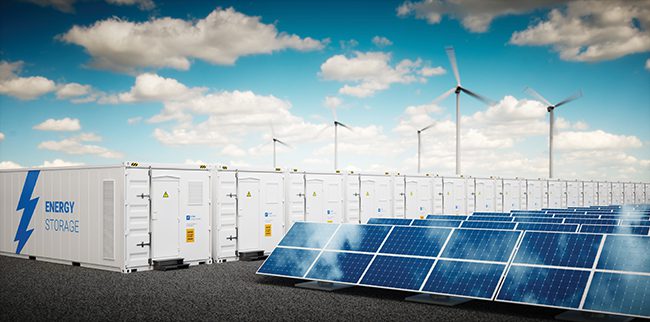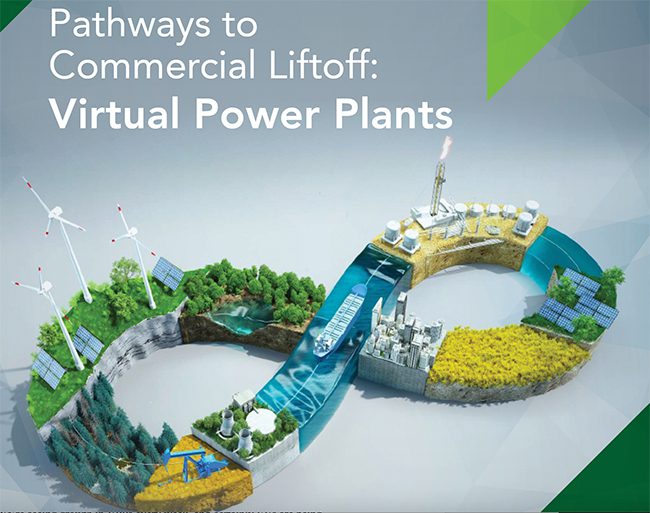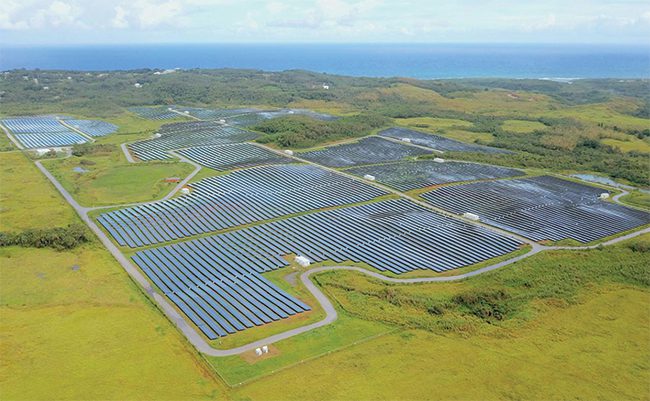Energy Storage, VPPs Accelerate Growth in Hybrid Power
The need for flexibility, sustainability, reliability, and resiliency in the electricity sector is bringing varied technologies together in the power generation mix.
Hybrid power plants are increasingly part of the power generation landscape, in large part due to the inclusion of energy storage at renewable energy installations, and the growth in what are known as virtual power plants (VPPs).
A hybrid plant is a facility incorporating two or more technologies, such as solar plus energy storage, or energy storage at a natural gas–fired power station. While the definition of a hybrid plant is simple, deployment of these systems can be complex. Different technologies must come together in a cohesive way, which means technical challenges must be addressed. Regulatory issues also can come into play.
The Electricity Markets & Policy group at the Lawrence Berkeley National Lab in California tracks larger hybrid power plant deployments, generally those with more than 1 MW of generation capacity, which excludes many behind-the-meter or virtual installations. The group in a September presentation discussed its most recent data, which showed that more than 200 solar photovoltaic (PV) hybrid plants were deployed across the U.S. at the end of 2022, comprising about 4 GW of energy storage capacity and 12.5 GWh of storage energy. The group said that hybrids represented 37%, or about 500 GW, of generation capacity in interconnection queues (up from 31% in 2021), including 48% of all solar generation capacity.
The Berkeley Lab noted that 2022’s Inflation Reduction Act—which expands tax credits for energy storage—and the Federal Energy Regulatory Commission’s Order No. 2023 (issued in July 2023, designed to improve interconnection procedures and agreements), both likely will impact deployment of hybrid plants. The U.S. Department of Energy (DOE), meanwhile, is pushing for more deployment of VPPs through its Loan Programs Office.
Want to learn more about VPPs? Read “Virtual Power Plants: The Next Operational Model for Electricity Generation,” an online sidebar in the December 2023 issue of POWER. You also should read this POWER exclusive, “Electrification: Plugging into the future of energy.”
Dr. Harish Sarma Krishnamoorthy, an associate professor at the University of Houston in the electrical and computer engineering department, said utilities should be promoting the design and development of hybrid power plants, including VPPs, as a way to increase power generation without large infrastructure investments.
“Absolutely, utilities should be at the forefront of these developments. It will lead to energy sustainability as well as affordability in addition to improved resiliency, lower system losses, and lower emissions,” Krishnamoorthy told POWER. “However, it is important for utilities to work in collaboration with other stakeholders, such as government agencies, independent power producers, technology providers, and local communities. A holistic approach that considers the interests of all parties is essential for long-term success.”
Energy Storage
As Krishnamoorthy noted, investments in hybrid plants are seen as a way to provide more power to the grid without the need for building new utility-scale facilities, or for making major investments in transmission and distribution (T&D) infrastructure. That includes putting battery energy storage systems (BESS) at existing thermal and renewable power plants (Figure 1) to increase generation capacity, using the T&D infrastructure already in place.
 |
|
1. Hybrid power plants utilize two or more technologies to generate energy, with most incorporating solar and/or wind power, along with energy storage systems. Source: Shutterstock |
“Our domestic power plants are staring down at a tsunami of demand from several channels. Whether it is a result of population growth, technological advancements, the electrification of energy, transportation, climate control, or behavioral changes, significant transmission upgrade investment is essential to ensure the reliability, flexibility, and sustainability of the U.S. electrical grid,” said Eric Cherniss, founder and head of development for Elevate Renewables, a national renewable energy development firm specializing in BESS. “We believe that private investment in energy storage is an efficient and logical solution to mitigate the cost of increasing demand on our electric power infrastructure. Not only does energy storage facilitate our national clean energy initiative as well as help decarbonize the grid, but a non-wires alternative will also be significantly cheaper for the ratepayer.”
Elevate Renewables focuses on co-locating BESS at existing large generation facilities owned by private equity funds managed by ArcLight Capital Partners. The company is developing such hybrid projects at ArcLight’s existing 25-GW power infrastructure portfolio, with a brownfield development pipeline of about 5 GW at more than 25 project locations.
“As we enter into the clean energy transition, we have made it our mission to prioritize clean energy investments in environmental justice and other overburdened communities,” said Tonja Wicks, Elevate’s vice president of Regulatory Affairs. Wicks told POWER, “Elevate focuses redevelopment on brownfield sites in communities that have borne the burden of environmental impacts to retain jobs, tax base, and maintain reliability.”
Krishnamoorthy noted the importance of energy storage in multiple ways, noting that “with a growing penetration of renewable energy sources in the grid, supply intermittencies will be experienced more often … hence, energy storage systems will be critical to maintain the balance and regulate system frequency.”
Krishnamoorthy told POWER that the list of hybrid plants “we are most likely to see designed and developed in the near future” include:
- ■ Solar and Energy Storage. These hybrid plants can store excess energy generated during the day and provide power at night or during cloudy periods, increasing the reliability of renewable energy sources.
- ■ Wind and Energy Storage. Wind turbines can be combined with energy storage systems to smooth out energy production and provide a more consistent power supply.
- ■ Natural Gas and Renewable Energy. In remote or off-grid locations (including offshore systems), combining stable natural gas (or biomass) generators with renewables like solar and wind (and even energy storage systems) can reduce the reliance on fossil fuels and lower emissions.
- ■ Hybrid Energy Storage Systems. Said Krishnamoorthy: “While battery systems can provide high power densities, hydrogen-based energy storage systems can provide high energy densities (supporting long-duration energy storage). Hence, we may see ‘hybrid energy storage systems’ in the near future to get the best of the two worlds.”
Virtual Power Plants
VPPs are aggregations of distributed energy resources (DERs), and can include rooftop solar paired with battery energy storage, backup generators paired with storage, and smart appliances working with generators, storage, rooftop solar, and even small-scale wind turbines. These VPPs also may feature electric vehicles (EVs) and chargers. The installations are often residential, but also can be utilized at commercial and industrial sites to help with their power loads. These virtual plants help balance electricity demand and supply, and can provide grid services in the same way as a traditional power plant.
 |
|
2. The U.S. Department of Energy’s (DOE’s) recent report on virtual power plants (VPPs) provides information on the market for VPPs, detailing their value proposition, associated business models, and the technology being used today. Source: DOE |
The DOE issued a report in September (Figure 2) noting how the agency is working to support deployment of VPPs in the U.S. to make the grid “more flexible, affordable, clean, and resilient as the economy electrifies.” The report noted, “VPPs are at an inflection point due to market and technical factors, including increased adoption of distributed energy resources, improvements in device software and VPP platforms, and advancements in grid integration software.”
Jigar Shah, director of the Loan Programs Office at the DOE, met with POWER in September at the RE+ trade show in Las Vegas. Shah said VPPs will be a key near-term solution to existing energy challenges, including interconnection backlogs, peak demand increases, and distribution system congestion. He said his office can finance VPP-related projects that support grid flexibility, resilience, and reliability, and help provide “equitable clean energy access.”
Shah told POWER, “We’re seeing growth in VPPs every week, and certainly EVs are being added every week. And you can see the interest level from utilities; they understand the need for DERs [distributed energy resources] in the energy transition. The DOE has an incredible role to play, from developing standards for operations and cybersecurity, and with our national labs.”
Shah, who prior to joining the DOE was co-founder and president of Generate Capital, and who is well-known for his support of clean energy and decarbonization projects, said, “VPPs are more affordable” than spending capital on T&D infrastructure. “We have proven models in California, Texas, New York, North Carolina … we have interest from utilities and third parties.”
Shah said VPPs open the grid to a new utility-scale, behind-the-meter electricity supply, and also coordinate “disparate DERs into holistic, demand-flexible resources.” He noted that VPP participants can be compensated for their efforts, while also making power generation more affordable and reliable.
The DOE report notes that “30–60 GW of VPP capacity today is in demand response programs that are used when bulk power supply is limited; these programs turn off or decrease consumption from DERs such as smart thermostats, water heaters, and commercial and industrial equipment. However, VPPs have the technical potential to perform a wider array of functions.
“Example functions of VPPs on the market today include shifting the timing of EV charging to avoid overloading local distribution system equipment, supplying homes with energy from onsite solar-plus-storage systems during peak hours to reduce demand on the bulk power system, charging distributed batteries at opportune times to reduce utility-scale solar curtailment, dispatching energy from commercial EV batteries back to the grid, and contributing ancillary services to maintain power quality, all while minimizing impact to the DER owner.”
Case Studies
The complexity of some hybrid set-ups is illustrated in case studies provided to POWER from PXiSE, a technology solutions company. The group said the 205-MW Tranquility solar facility in 2021 became one of the first co-located solar and storage projects operating in the California market, when the project added two BESSs, with 72 MW/288 MWh of capacity. Tranquility is located on 1,900 acres of former farmland in Fresno County. Its output is primarily for Southern California Edison under a long-term power purchase agreement.
PXiSE implemented its Renewable Power Plant Controller “to provide the necessary coordination and integration between the pre-existing solar PV communication and control equipment and the new BESS equipment.” The group said the equipment provides “independent control of the BESS and PV,” and “allows for energy shifting as well as an independent response to Southern California Edison’s dispatch signals, all in compliance with strict cybersecurity protocols.”
 |
|
3. This solar array on the island of Guam, serving the Guam Power Authority, utilizes equipment from PXiSE to support energy storage systems from LG Chem. A PXiSE controller enables aggregation of energy from the solar farm and batteries as a single VPP. Courtesy: PXiSE |
An installation in Guam (Figure 3), serving the Guam Power Authority (GPA), utilizes PXiSE equipment to support energy storage systems from LG Chem. The systems, installed by LG CNS, use one battery to mitigate solar power fluctuation and a second battery to provide frequency support. PXiSE was brought on board to provide the system controller to coordinate the charging and discharging of the energy storage system to meet the GPA’s requirements. The controller enables aggregation of energy from the solar farm and batteries as a single VPP. The system also can expand as more assets are added.
The U.S. military accounts for about one-fifth of Guam’s power consumption, a level expected to increase next year as there are plans to relocate military personnel from Okinawa to Guam in 2024. Guam, which long has imported petroleum to meet its energy needs, is expected to continue to deploy renewable energy resources to become more energy independent, with hybrid plants—solar and storage, and wind with storage—expected to become more important.
Integration Challenges
Designers and developers of hybrid power plants face several significant challenges when integrating multiple energy sources into a single system. Krishnamoorthy said those include grid integration, “as coordinating the output of multiple energy sources, especially in large-scale hybrid systems, requires advanced grid integration solutions.” Another challenge is control and optimization—noted in the PXiSE case studies—which involves utilizing “effective control strategies that intelligently balance and distribute energy from various sources to meet demand, while maintaining grid stability … [that is] necessary to optimize the operation of hybrid power plants.”
Krisnamoorthy told POWER that “regulatory and policy frameworks may not always accommodate or incentivize hybrid power plants.” He also said utilities should look at installing hybrid power plants at locations that can take advantage of existing T&D infrastructure—such as at sites of retired thermal power plants.
“At the University of Houston, for example, we have been working on offshore hybrid power plant design, control, and coordination,” said Krishnamoorthy. “On top of that, we are looking to utilize retired offshore distributed infrastructure and oil and gas platforms to reduce the overall costs of installation. We are also exploring repurposing traditional oil and gas pipelines to transport hydrogen, which can be used to power hybrid power plants. Similar things can be done with retired thermal power plants. However, the costs incurred during repurposing need to be carefully compared to the cost of a new plant.”
Krishnamoorthy reiterated that “energy storage systems will be pivotal to realize the full potential of clean and renewable energy sources,” so expect storage to be part of most future hybrid installations. “It is expected that long-duration energy storage systems can support the deep decarbonization goals of the industry and reduce its CO2 emissions by 12% to 15%, or more,” Krishnamoorthy said. “If we don’t have sufficient energy storage capacity installed on the grid, we will significantly underutilize the available resources.”
—Darrell Proctor is a senior associate editor for POWER (@POWERmagazine).